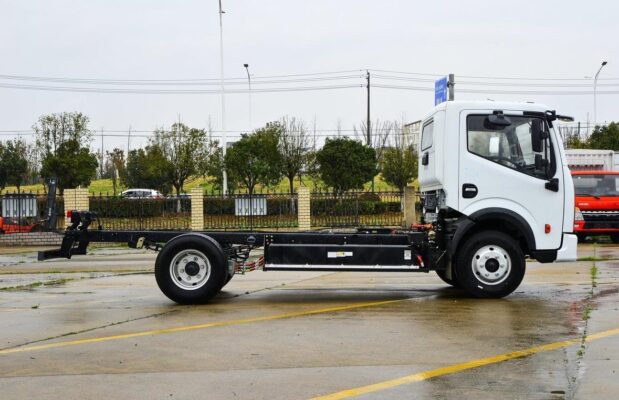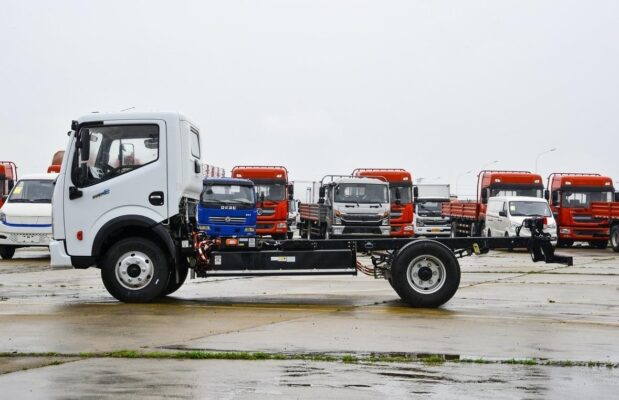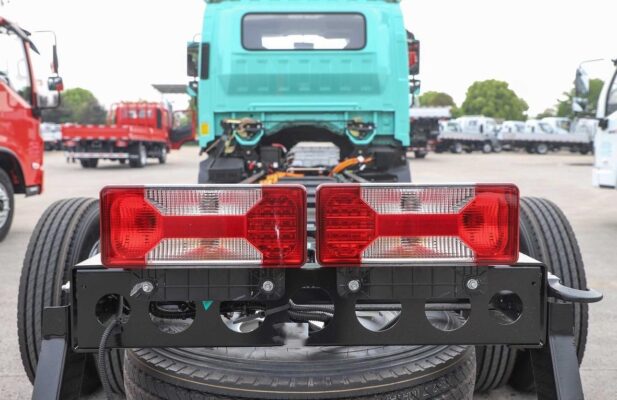Electric Truck Knowledge
Maintenance of Dump Trucks Is quite Different Turn You into a Vehicle Maintenance Expert in Minutes
Posted on by Electric Trucks
In engineering construction and ore transportation, vörubílls have always played an important role. They are usually heavily loaded, operate in poor conditions and have a great amount of wear and tear. Therefore, the general service life of a vörubíll is about 3 years, and the cost of vehicle replacement is very high. In order to make your beloved vehicle last longer and earn more wealth for yourself, TruckNet has specially prepared maintenance secrets of vörubílls for you. Hope it can be helpful to truck drivers.

Dump Trucks Working in Mines
The main difference between a vörubíll and a general vehicle lies in the lifting function. The hydraulic cylinder is crucial, so the inspection of the hydraulic system is very important.
(1) Check the hydraulic oil quantity of the vörubíll. If it is insufficient, replenish it in time. Check whether the hydraulic system is damaged or leaking. If necessary, handle it in time. A shortage of hydraulic oil can lead to inefficient operation or even failure of the lifting mechanism. Regular checks and prompt replenishment ensure smooth functionality.
(2) Pay attention to and check whether the connections and fastenings among components such as the upper and lower supports and the linkage mechanism of the hydraulic cylinder of the vörubíll are reliable. Observe whether there is any abnormal damage or deformation on each moving part and its adjacent fixed parts. Loose connections or damaged components can pose significant safety risks and affect the performance of the vehicle.
(3) Check the intact condition of the compartment, subframe and spare tire frame of the vörubíll. Pay special attention to checking whether there are any phenomena such as weld cracking or cracks. Cracks or weld failures can compromise the structural integrity of the vehicle and lead to potential breakdowns.
(4) Check the working or wear conditions of moving parts such as the gear pump, power take-off and hydraulic cylinder of the vörubíll, and perform maintenance, repair and replacement of wearing parts. Regular inspection and timely replacement of worn parts prevent unexpected failures and ensure the efficient operation of the vehicle.
In addition, daily maintenance is also very important. Every week or after every 50 working hours, the following items of the vörubíll should be inspected regularly: Check whether there is any leakage of all gas and oil circuits of the vörubíll, and replace the damaged hose in time. Leaking hoses can lead to fluid loss and potential safety hazards. Check whether all bolts and nuts are loose. If so, tighten them in time. Loose bolts and nuts can cause components to come loose and affect the stability of the vehicle. Check whether the valves and hydraulic cylinders on the vehicle are dirty. If so, clean them. Clean components ensure optimal performance and longevity. Each greasing point must be greased once to ensure the normal operation of the vehicle. Adequate lubrication reduces friction and wear. Check the condition of the skids, rubber pads or rubber strips. If they are aging, replace them in time. Worn skids and pads can affect the functionality and safety of the vehicle.

In addition, for the maintenance of vörubílls, the following points should also be emphasized:
(1) The high-pressure hose of the vörubíll must be replaced every two years. If it is found that the hose is cracked, damaged or partially expanded, it should be replaced in time. Failing to replace damaged hoses can lead to sudden failures and potential accidents.
(2) Check frequently whether there is any air leakage or oil seepage in the tilting mechanism of the vörubíll. When filling the hydraulic oil, check whether the filter screen installed at the filling port is damaged. If necessary, replace it to avoid impurities from mixing in and accelerating the wear or early damage of the hydraulic components. It is strictly prohibited to mix different brands of hydraulic oil or fill hydraulic oil that does not meet the requirements of the manual. Using the wrong type of hydraulic oil can cause significant damage to the system.
(3) Check frequently whether the meshing and separation of the power take-off and gear pump of the vörubíll are normal to avoid accidental lifting of the compartment due to incomplete separation. During working conditions, also pay attention to whether there are abnormal phenomena such as abnormal noise or excessive temperature of the vehicle. If necessary, eliminate them in time to avoid premature damage of the power take-off, gear pump, valves, etc. Unusual noises or excessive heat can be indicators of underlying problems that require immediate attention.
(4) When repairing the vörubíll, check the working surface of the piston rod of the hydraulic cylinder to see if there are any phenomena such as bumps or scratches. If there are, repair or replace them in time. Otherwise, the working performance of the hydraulic cylinder will be significantly reduced. Damaged piston rods can affect the lifting capacity and efficiency of the vehicle.
(5) Check frequently whether the locking mechanism of the rear compartment plate of the vörubíll is reliable, and adjust it to a reasonable automatic opening and closing angle to prevent accidents caused by the unexpected opening of the rear compartment plate or the inability to open when lifting; When dumping large materials, the rear compartment plate should be removed to avoid damaging the rear compartment plate. A faulty locking mechanism can lead to safety hazards and damage to the vehicle and its cargo.
(6) When repairing the vörubíll, pay attention to cleanliness to prevent debris from entering the hydraulic system to avoid wear of components, blockage of valves, etc., resulting in reduced working performance. Keeping the system clean is essential for its proper operation.
(7) If the dump garbage truck is out of service for a long time, it should be inspected according to the inspection contents of a new vehicle before reuse. It can be reused after passing the inspection. A thorough inspection after a period of inactivity ensures the vehicle is in proper working condition.
(8) Check frequently whether the connection between the chassis frame and the subframe of the chassis vehicle is reliable, whether the U-bolts and shear-resistant irons are loose, and whether the backing plates, rubber pads or rubber blocks are firmly fixed. If there is looseness or dislocation, they must be tightened and reset. A secure connection between the chassis and subframe is crucial for the stability and safety of the vehicle.
(9) The hydraulic oil must be kept clean and replaced regularly and promptly. The hydraulic oil should undergo precipitation for 48 hours before being injected into the fuel tank. The filtering accuracy of the hydraulic oil is <25 μm. (The fuel tank should be cleaned regularly to remove sediments. The hydraulic oil should be replaced regularly according to the deterioration condition, but the longest replacement period is one year) Regular oil changes and clean tanks ensure the smooth operation of the hydraulic system.
(10) The lubrication points of each transfer part of the vörubíll should be filled with grease regularly, using No. 2 lithium-based grease for automobiles. Proper lubrication extends the life of moving parts.

Let’s consider a real-life scenario where a vörubíll driver neglects these maintenance checks. The hydraulic oil hasn’t been changed for an extended period, and the high-pressure hose shows signs of wear but isn’t replaced. One day, while on a job, the hose ruptures, causing the lifting mechanism to fail suddenly. This not only delays the work but also incurs significant repair costs and potential safety risks.
Now, let’s look at the benefits of meticulous maintenance. A driver who religiously follows the maintenance schedule notices a minor issue with a valve during a routine check. By addressing it promptly, they prevent a potential major breakdown that could have left the vehicle out of commission for an extended period.
In the future, as technology continues to advance, maintenance practices for vörubílls may become more sophisticated. Sensors and monitoring systems could provide real-time data on the condition of various components, allowing for predictive maintenance and reducing the risk of unexpected failures.
Ennfremur, new materials and lubricants may emerge that offer better performance and longer service intervals. However, even with these advancements, the fundamental principles of regular inspection, cleaning, and component replacement will remain crucial.
In conclusion, maintaining a vörubíll is a responsibility that requires diligence and attention to detail. By adhering to a comprehensive maintenance routine and addressing issues promptly, truck drivers can ensure the longevity, öryggi, and efficiency of their vehicles. This not only saves money in the long run but also contributes to a successful and productive operation.
For example, imagine a fleet owner who implements a strict maintenance program for all their vörubílls. The result is reduced downtime, lower repair costs, and increased customer satisfaction due to reliable service. This positive reputation can lead to more business opportunities and a competitive edge in the market.
Another example could be a driver who takes the time to clean and inspect the vehicle thoroughly after a particularly challenging job. By doing so, they uncover a hidden crack in a critical component and are able to have it repaired before it causes a major problem on the road.
In summary, the key to successful vörubíll maintenance lies in a combination of consistent effort, knowledge of the vehicle’s requirements, and a commitment to keeping the vehicle in top condition.